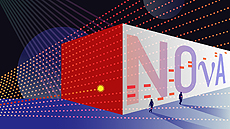Fermilab's 500-mile neutrino experiment up and running
 |
| With construction completed, the NOvA experiment has begun its probe into the mysteries of ghostly particles that may hold the key to understanding the universe.
Image: Fermilab/Sandbox Studio |
Editor's note: Visit the press release Web page to view three videos — including a new animation and a new time-lapse video — related to the NOvA experiment.
It's the most powerful accelerator-based neutrino experiment ever built in the United States and the longest-distance one in the world. It's called NOvA, and after nearly five years of construction, scientists are now using the two massive detectors — placed 500 miles apart — to study one of nature's most elusive subatomic particles.
Scientists believe that a better understanding of neutrinos, one of the most abundant and difficult-to-study particles, may lead to a clearer picture of the origins of matter and the inner workings of the universe. Using the world's most powerful beam of neutrinos, generated at the U.S. Department of Energy's Fermi National Accelerator Laboratory near Chicago, the NOvA experiment can precisely record the telltale traces of those rare instances when one of these ghostly particles interacts with matter.
Construction on NOvA's two massive neutrino detectors began in 2009. In September, the Department of Energy officially proclaimed construction of the experiment completed, on schedule and under budget.
"Congratulations to the NOvA collaboration for successfully completing the construction phase of this important and exciting experiment," said James Siegrist, DOE associate director of science for high energy physics. "With every neutrino interaction recorded, we learn more about these particles and their role in shaping our universe."
NOvA's particle detectors were both constructed in the path of the neutrino beam sent from Fermilab in Batavia, Illinois, to northern Minnesota. The 300-ton near detector, installed underground at the laboratory, observes the neutrinos as they embark on their near-light-speed journey through the Earth, with no tunnel needed. The 14,000-ton far detector — constructed in Ash River, Minnesota, near the Canadian border — spots those neutrinos after their 500-mile trip and allows scientists to analyze how they change over that long distance.
For the next six years, Fermilab will send tens of thousands of billions of neutrinos every second in a beam aimed at both detectors, and scientists expect to catch only a few each day in the far detector, so rarely do neutrinos interact with matter.
From this data, scientists hope to learn more about how and why neutrinos change between one type and another. The three types, called flavors, are the muon, electron and tau neutrino. Over longer distances, neutrinos can flip between these flavors. NOvA is specifically designed to study muon neutrinos changing into electron neutrinos. Unraveling this mystery may help scientists understand why the universe is composed of matter and why that matter was not annihilated by antimatter after the big bang.
Read more
|